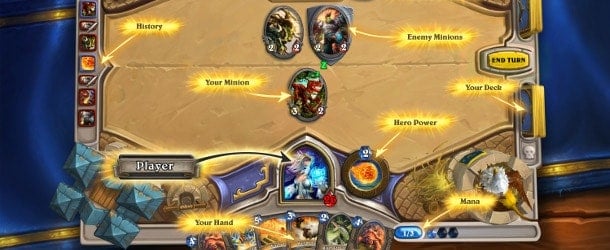Back when I was in high school (and in my early days of University), I used to play Magic: The Gathering. It was more of a hobby than anything; I was never particularly skilled at the game, nor did I have the desire to shell out the necessary funds for a powerful deck. Looking back, I suppose such titles effectively epitomized the mindset that would eventually evolve into the pay-to-win genre: although strategy and intelligence played an integral part in whether or not one could achieve victory, in order to construct a truly effective deck, one needed to shell out cash – and usually a fair sum, at that.
As such, the guy with the biggest wallet won more often than he should.
It was for that reason that when Blizzard announced Hearthstone: Heroes of Warcraft – a free-to-play online CCG – I was a bit leery as to how they might pull such a thing off – particularly in light of how thoroughly they mishandled the now-defunct real money auction house in Diablo III. As such, it was with some trepidation that I picked up the game and started playing…
Only to find that it was actually really awesome.
Although some card game veterans might find Hearthstone a little bit simplistic for their needs, it’s actually got a surprising degree of depth, while at the same time being simple enough that casuals (which I’m a bit ashamed to admit probably includes myself) aren’t overwhelmed at the outset. When you first start playing the game, you’re subjected to a brief tutorial in which you play as the Mage – one of the game’s nine classes. After that, you’re basically thrust into the game proper. From there, it’s a matter of figuring out which class best suits your play-style. Once you’ve chosen one, play it until you reach max level – and have access to all the basic class cards.
Although everybody draws on the same neutral minion pool, each class has access to a host of unique monsters, spells, and equipment. This opens up the door to a number of class-specific combinations and strategies, both of which contribute a great deal to the overall meta of Hearthstone. Warlocks, for example, can sacrifice two life in order to draw a card; Priests, on the other hand, are capable of healing either themselves of a minion for two life.
In order to unlock new cards (and build up your deck for ranked), you’re going to need to do two things: win casual (or ranked) matches and complete quests in order to get gold, breaking down earned cards you don’t need for dust(which can be used to ‘craft’ specific cards). The former is probably the most important; gold is required to unlock new packs (which can be purchased for 100 gold or for a small amount of real-world money) as well as gain access to the arena, a draft-mode styled game which gives you a guaranteed pack along with a bevy of other rewards.
In short…real-world money might give you an edge over other players, but only inasmuch as you’ll be able to open a few more packs, or do a few more arena runs. It’s entirely possible to make it to the top-tier levels of ranked without paying a single cent (several have done just that).
Now…I did say Hearthstone had a few problems. Arena mode – which sets you up with a choice of three random heroes then a selection of random cards – is heavily reliant on luck, even more so than any other format. You might end up with four legendaries in a single draft, or you might simply wind up with a whole deck filled with useless cards. The unfortunate side-effect of this process is that Mages – whose most powerful class cards are all common in rarity – tend to dominate most other classes except in rare cases. It’s more than a little frustrating when something like this happens, but your best bet is to just grin and bear it.
That’s a minor gripe, though. Overall, Hearthstone is an awesome game, and a fantastic diversion if you’ve a few minutes to kill at your computer. Grab if your yourself – I’d highly recommend it.

